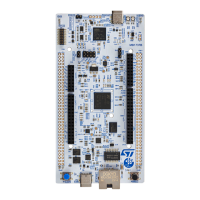6.10 Bootloader
The bootloader is located in the system memory, programmed by ST during production. It is used to reprogram
the flash memory via USART, I
2
C, SPI, CAN FD, or USB FS in device mode through the device firmware upgrade
(DFU). The bootloader is available on all devices. Refer to the application note STM32 microcontroller system
memory boot mode (AN2606) for more details.
The root secure services (RSS) are embedded in a flash area named the secure information block, programmed
during ST production. For example, it enables secure firmware installation (SFI), thanks to the RSS extension
firmware (RSSe SFI). This feature allows customers to protect the confidentiality of the firmware to be provisioned
into the STM32 when production is subcontracted to an untrusted third‑party. The root secure services are
available on all devices, after enabling the
TrustZone
®
through the TZEN option bit.
The I/O BOOT0 gives external hardware access to the bootloader.
By default, this pin is set to level LOW by a pull‑down resistor. It is possible to put this I/O to level HIGH by
connecting a 2.54 mm pitch jumper between the Zio connector (CN11) pin 7 and VDD pin 5.
As mentioned above, USART3 on PD8/PD9 is connected by default because this interface supports the
Bootloader mode.
6.11 Octo‑SPI flash memory
The Octo‑SPI flash memory has the following characteristics: 256 Mbits, 1.8 V, 200 MHz, DTR, read‑while‑write. It
is connected to the OCTOSPI interface of the STM32H7S3L8H6 microcontroller.
The embedded footprint is also compatible with many other references in the BGA24 package. Check the
compatibility of the memory datasheet versus the
MB1737 schematics.
6.12
USB Type-C
®
(HS, DRP)
The STM32H7Rx/7Sx Nucleo-144 supports a USB HS 2.0 interface on the USB Type-C
®
receptacle connector
(CN2). It offers compatibility with USB Type-C
®
rev 1.3, USB PD 3.0, PPS, and USB BC 1.2 on the USB Type-C
®
receptacle connector (CN2).
CN2 can be used as a DRP (dual‐role port). Its VBUS can be managed for supplying other platforms as a
Provider, or to be supplied as a Consumer. TCPP03-M20 is used to manage DRP functions. It is compatible with
VBUS current up to 1.5 A and VBUS 5V only.
By default, the dead battery (DB) feature of this USB connector is managed by TCPP03-M20. If PM2(DB1) and
PM3(DB2) of STM32H7S3L8H6 are needed, SB26 and SB28 must be ON (default OFF).
The green LED (LD4) is lit when one of the following events occurs:
• The source path is open and NUCLEO-H7S3L8 provides up to 1.5A 5V power on CN2.
• VBUS is powered by another USB Host when NUCLEO-H7S3L8 works as a sink device.
UM3276
Hardware layout and configuration
UM3276 - Rev 1
page 23/40

